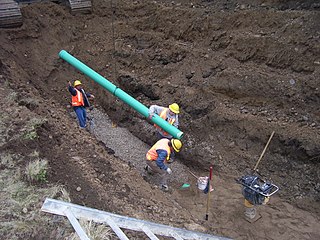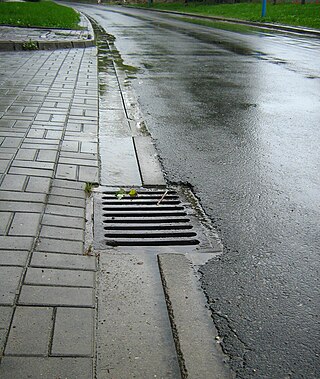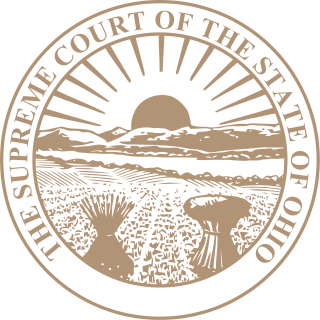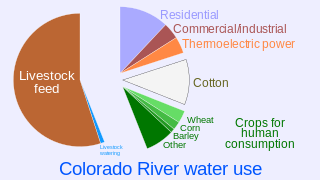
Drainage is the natural or artificial removal of a surface's water and sub-surface water from an area with excess water. The internal drainage of most agricultural soils can prevent severe waterlogging, but many soils need artificial drainage to improve production or to manage water supplies.

A drainage basin is an area of land in which all flowing surface water converges to a single point, such as a river mouth, or flows into another body of water, such as a lake or ocean. A basin is separated from adjacent basins by a perimeter, the drainage divide, made up of a succession of elevated features, such as ridges and hills. A basin may consist of smaller basins that merge at river confluences, forming a hierarchical pattern.

Stormwater, also written storm water, is water that originates from precipitation (storm), including heavy rain and meltwater from hail and snow. Stormwater can soak into the soil (infiltrate) and become groundwater, be stored on depressed land surface in ponds and puddles, evaporate back into the atmosphere, or contribute to surface runoff. Most runoff is conveyed directly as surface water to nearby streams, rivers or other large water bodies without treatment.

A sanitary sewer is an underground pipe or tunnel system for transporting sewage from houses and commercial buildings to a sewage treatment plant or disposal.

A storm drain, storm sewer, highway drain, surface water drain/sewer, or stormwater drain is infrastructure designed to drain excess rain and ground water from impervious surfaces such as paved streets, car parks, parking lots, footpaths, sidewalks, and roofs. Storm drains vary in design from small residential dry wells to large municipal systems.

Water resources law is the field of law dealing with the ownership, control, and use of water as a resource. It is most closely related to property law, and is distinct from laws governing water quality.

A French drain is a trench filled with gravel or rock, or both, with or without a perforated pipe that redirects surface water and groundwater away from an area. The perforated pipe is called a weeping tile. When the pipe is draining, it "weeps", or exudes liquids. It was named during a time period when drainpipes were made from terracotta tiles.
Riparian water rights is a system for allocating water among those who possess land along its path. It has its origins in English common law. Riparian water rights exist in many jurisdictions with a common law heritage, such as Canada, Australia, New Zealand, and states in the eastern United States.
Water right in water law is the right of a user to use water from a water source, e.g., a river, stream, pond or source of groundwater. In areas with plentiful water and few users, such systems are generally not complicated or contentious. In other areas, especially arid areas where irrigation is practiced, such systems are often the source of conflict, both legal and physical. Some systems treat surface water and ground water in the same manner, while others use different principles for each.

A balancing lake is a term used in the U.K. describing a retention basin used to control flooding by temporarily storing flood waters. The term balancing pond is also used, though typically for smaller storage facilities for streams and brooks.
Tile drainage is a form of agricultural drainage system that removes excess sub-surface water from fields to allow sufficient air space within the soil, proper cultivation, and access by heavy machinery to tend and harvest crops. While surface water can be drained by pumping, open ditches, or both, tile drainage is often the most effective means of draining subsurface water.
Sanitation in ancient Rome, acquired from the Etruscans, was very advanced compared to other ancient cities and provided water supply and sanitation services to residents of Rome. Although there were many sewers, public latrines, baths and other sanitation infrastructure, disease was still rampant. The baths are known to symbolise the "great hygiene of Rome".
The rule of capture or law of capture, part of English common law and adopted by a number of U.S. states, establishes a rule of non-liability for captured natural resources including groundwater, oil, gas, and game animals. The general rule is that the first person to "capture" such a resource owns that resource. For example, landowners who extract or “capture” groundwater, oil, or gas from a well that bottoms within the subsurface of their land acquire absolute ownership of the substance even if it is drained from the subsurface of another’s land. The landowner who captures the substance owes no duty of care to other landowners. For example, a water well owner may dry up wells owned by adjacent landowners without fear of liability unless the groundwater was withdrawn for malicious purposes, the groundwater was not put to a beneficial use without waste, or "such conduct is a proximate cause of the subsidence of the land of others." An exception to the rule of capture is that a person who drills for groundwater, oil, or gas may not extract the substance from a well that bottoms within the subsurface estate of another by drilling on a slant.

The Falconbrook was a stream that rose in Balham and Tooting, draining much of those parishes then the south and west of the larger district of Battersea including Clapham Junction to enter the London reaches of the Thames. Before doing so, it briefly formed the border of Wandsworth Town, reflected in the SW11/SW18 boundary today.
An easement is a nonpossessory right to use and/or enter onto the real property of another without possessing it. It is "best typified in the right of way which one landowner, A, may enjoy over the land of another, B". An easement is a property right and type of incorporeal property in itself at common law in most jurisdictions.
A converted wetland is one that has been drained, dredged, filled, leveled, or otherwise altered for the production of an agricultural commodity. The definition is part of The Highly Erodible Land Conservation and Wetland Conservation Compliance provisions (Swampbuster) introduced in the 1985 Farm Bill. The provisions aim to reduce soil loss on erosion-prone lands and to protect wetlands for the multiple benefits they provide.

Cline v. American Aggregates Corporation, 474 N.E.2d 324, was a case decided by the Supreme Court of Ohio that first applied the reasonable use doctrine to water use in that state.

Water law in the United States refers to the Water resources law laws regulating water as a resource in the United States. Beyond issues common to all jurisdictions attempting to regulate water's uses, water law in the United States must contend with:

Holderness Drain is the main feature of a Land Drainage scheme for the area of Holderness to the east of the River Hull in the East Riding of Yorkshire, England. Construction began in 1764, and several notable civil engineers were involved with the scheme over the years. Despite the high costs of the initial scheme, it was not particularly successful, because of the refusal of the ship owners of Hull to allow an outlet at Marfleet. They insisted that the water be discharged into the River Hull to keep the channel free of silt. Following a period of agricultural depression and the building of new docks in the early 1800s, an outlet at Marfleet was finally authorised in 1832. A high level system still fed upland water to the Hull, but the low level system discharged into the Humber, where levels were considerably lower. Following the success of steam pumping on the Beverley and Barmston Drain, the trustees looked at such a possibility for the Holderness Drain, but the development of the Alexandra Dock in the 1880s and then the King George V Dock in 1913 provided a solution, as the docks were topped up with water pumped from the drain, to lessen the ingress of silt-laden water.

A gravity sewer is a conduit utilizing the energy resulting from a difference in elevation to remove unwanted water. The term sewer implies removal of sewage or surface runoff rather than water intended for use; and the term gravity excludes water movement induced through force mains or vacuum sewers. Most sewers are gravity sewers because gravity offers reliable water movement with no energy costs wherever grades are favorable. Gravity sewers may drain to sumps where pumping is required to either force sewage to a distant location or lift sewage to a higher elevation for entry into another gravity sewer, and lift stations are often required to lift sewage into sewage treatment plants. Gravity sewers can be either sanitary sewers, combined sewers, storm sewers or effluent sewers.












